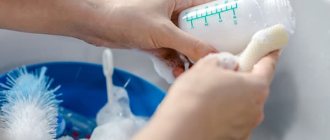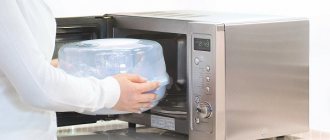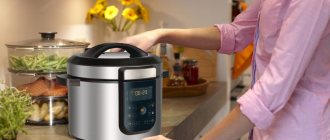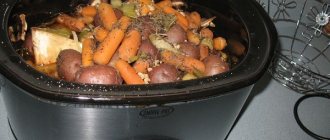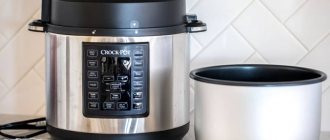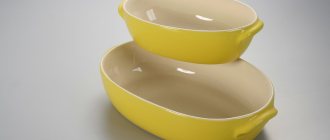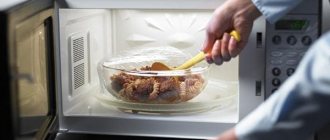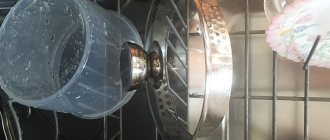What can be sterilized in a slow cooker?
Sterilization is the removal of any object from bacteria, microorganisms, viruses, etc. In this case, sterilization can be carried out using thermal, chemical, radiation or filtration treatment.
When talking about sterilization at home, we most often mean heat treatment of glass jars and lids for sealing pickles, pickles, jams, etc.
However, this is not the entire list of what can be sterilized in a slow cooker:
- Banks
- Lids
- Baby bottles
- Nipples
- Manicure tools
- Scissors, etc.
Being sure that an item is sterile can be very important, for example, when you work as a hairdresser or do manicures at home. In this case, sterile instruments are a guarantee of safety, both for yourself and for the client. However, most often it is young mothers who resort to sterilization who want to protect their infants with their immature immunity from encounters with bacteria. At the same time, you can sterilize not only jars and pacifiers, but also children's toys, rattles, teethers - everything that a child most often puts in his mouth. At the same time, sterilizing jars in a slow cooker is much easier and safer.
The main condition is that this item must fit into the multicooker bowl. It should be noted that sterilization in a multicooker can be done using steam and water methods.
How to wash and sterilize baby bottles
Every woman, having become a mother for the first time, initially thinks about how to maintain the health of her baby. In Russia, many pediatricians recommend sterilizing the dishes from which babies eat and drink. In Europe, this is taken more simply and they suggest keeping the child in more natural conditions, without creating an incubator.
Each mother makes her own decision on how to care for her child. And when there is concern about the baby’s health, it is better to play it safe. If you decide to keep your child in extremely clean conditions, let's look at all the options for washing and sterilizing bottles.
How often and for how long should bottles be sterilized?
It is not always necessary to sterilize before each feeding, but there are some conditions under which disinfection is required.
- After a child's illness.
- After prolonged use of feeding utensils, with clearly visible contamination.
- After purchasing a new container.
Another frequently asked question concerns the age at which baby care and feeding equipment should be sterilized. Pediatricians believe that the minimum threshold is the age of 4 months (until the baby begins to actively explore the world), and the maximum is the age of 1.5 years (when the immune system is fully strengthened).
The Avent baby bottle is ready for use after sterilization
Before starting the sterilization process, the dishes for feeding babies must be thoroughly washed, after unscrewing the caps from the bottles and removing the nipples from them.
How to wash
- Containers for feeding children must be washed very carefully. For deep penetration, to the very bottom of the bottle, you can use a brush.
- Each part should be washed separately, washing away any remaining mixture or other type of food from the grooves and bulges.
- If the dishes are heavily soiled, you can soak them for a while to make it easier to clean the dishes from dirt.
- You can also use a dishwasher with the addition of special detergents to wash children's dishes. After this method, sterilization is usually not necessary if the full cycle of the machine is used.
Here are the main points that answer the question “How to wash baby bottles?”
What to wash with
Conventional dishwashing detergents are not suitable for small children and newborns. There are several options for washing children's dishes:
- Laundry soap with warm water.
- Soda with warm water.
- Special detergents for children's dishes.
If sterilization after washing is not provided, then dishes washed using any detergents should be thoroughly rinsed with clean water and dried, laid out on a previously prepared clean towel.
Chicco plastic bottle disassembled piece by piece for sterilization
Sterilization of nipples and plastic utensils
We should talk about nipples and plastic separately. If you use high-quality cookware from trusted brands, then the question of processing methods will be removed even at the time of purchase. Manufacturers specializing in children's dishes offer products for purchase that are ready to withstand any type of heat treatment and still remain usable.
Low-quality plastic at high temperatures can release harmful substances that will negatively affect the baby’s health. Moreover, such plastic can become deformed under prolonged heat exposure.
Not every nipple can withstand regular exposure to high temperatures. For nipples, steam sterilization is best. Boiling is also possible, but you shouldn’t be overzealous with it.
Approaching the issue of purchasing feeding bottles responsibly will be an absolutely correct decision.
Sterilization methods
There are several ways to disinfect baby bottles:
- Boiling.
- Microwave.
- Steam sterilization.
- Cold sterilization.
Boiling
The most accessible and economical way. Pour the required amount of water into a large saucepan. The volume of water under which the container prepared for sterilization will be hidden is considered necessary. Pre-disassembled and washed feeding dishes are immersed in water and boiled for at least 10 minutes. We’ll look at how and what to wash dishes before sterilizing a little later.
The main inconvenience of boiling is the inability to process several feeding items at once. If you take a very large pan and try to boil several bottles at once, the disinfection process becomes very lengthy.
Microwave
The process of sterilizing plastic bottles for children in a special tank at maximum microwave power
Microwaves can also be used to treat food and drink utensils for newborns. There are two methods of microwave processing:
- Rapid boiling. Pre-prepared dishes are placed in a container of water and boiled in a microwave at high power. 5 - 7 minutes are enough to completely disinfect dishes in this way. The main disadvantage, as with regular boiling, is the small amount of dishes that can be processed at a time. The advantage over conventional boiling is that it takes less time.
- Steam treatment. Steam treatment in a microwave oven is possible using special bags or a sterilizer designed for this. Microwave sterilization packages can be purchased at children's stores or pharmacies. Dishes ready for processing are placed in a bag that is tightly closed and placed in the microwave for no more than 10 minutes. In this case, the microwave operates at full power. There are also microwave sterilizers designed to process several items at once. Compact devices that hold up to 6 bottles are equipped with a reservoir in which you can store disinfected glassware for 24 hours. The downside of this sterilizer is that it can process bottles with a volume of no more than 330 ml.
Steam sterilization
Steaming dishes for feeding children is possible in several ways.
- Steamer or multicooker. The processing principle is exactly the same. The prepared dishes are placed on a wire rack placed in the appliance. In the selected device, a special tank is filled with water, above which a grate with the objects being processed is located. The appropriate mode is turned on: “steaming” - 10 - 15 minutes; “sterilization”, if any, 5 - 7 minutes.
- Electric sterilizers. Designed specifically for disinfecting baby dishes using steam, and can also be equipped with a function for heating baby food. The advantages of such devices are, despite their external compactness, ease of use and the ability to process a large number of items at once. Also, sterilizers operating from the network are equipped with a timer that notifies the end of the processing process. Containers left in the sterilizer after disinfection remain sterile for 5 hours.
Cold sterilization
Cold sterilization involves the impact of chemicals on the containers being processed. The chemicals used for cold sterilization are completely safe for children, but after treatment, the dishes may have a specific odor. The usual rinsing of dishes with boiling water after the processing process will help get rid of possible odors.
For sterilization without steam and boiling, you need a large container with a lid and specially purchased tablets or granules for dissolving in cold water. The tablets contain drugs intended for antiseptic treatment.
- Add the tablets to a container of cold water until completely dissolved.
- Then the dishes prepared for disinfection are immersed in the resulting solution. Dishes placed in a container with sterilizing solution must be completely hidden by it.
- This solution can be used repeatedly during the day by placing new dishes in it for 30 minutes.
- Also, already treated dishes can be stored in this solution for 24 hours.
This method is very convenient in conditions where there is no electricity or the ability to use electrical appliances: maternity hospital, country house, travel.
Any sterilization of utensils for feeding babies, as well as other accessories, such as pacifiers or teethers, is available at home. There is no need to worry about the health of the child, having the ability to disinfect at any time.
Sterilizing baby bottles in a slow cooker
Many young mothers are concerned about the safety of their young children , so they strive to subject many things to thorough temperature treatment, but first of all, of course, baby bottles. This raises a logical question: is it possible to sterilize bottles in a multicooker or is it worth purchasing a separate device - a baby bottle sterilizer.
In terms of efficiency, a multicooker is not inferior to a baby sterilizer, and in terms of capabilities it even surpasses it: after all, a multicooker can sterilize not only jars, but also pacifiers, toys and much more.
And most importantly, the multicooker will help the young mother in the kitchen and prepare dinner while she is walking outside with the baby.
Many modern multicookers have a separate sterilization mode, but if the multicooker does not have such a mode, don’t worry, it can be easily replaced with the “steam cooking” mode.
To sterilize bottles and nipples in a multicooker, you need to pour 0.5 - 1 liter of water into the bowl. Then you should install a special stand for steaming. Before placing the bottles in the multicooker, they should be thoroughly washed with detergent or soda, and then placed on a stand with their necks down so that steam can easily penetrate inside, and the sterilization mode (or “steaming”) is started for 7-10 minutes. It is not necessary to close the lid of the multicooker, and in many cases it will not be possible due to the size of the bottles.
Read also: Apricots in syrup for the winter - recipes for slices without sterilization, whole apricots with pits and without cooking
How to sterilize baby bottles
Immediately after birth, children are most susceptible to bacterial and viral infections, which lead to other, more severe diseases from stomatitis to gastroenteritis. Sterilization of bottles significantly reduced the risk of intestinal and related diseases. Disinfection is a necessary rule during the first year of a child’s life, when his body is not yet strong enough to resist various viral diseases. We conducted our own research and found out in what cases and where it is better to sterilize dishes for a newborn baby. Our experts assessed the advantages and disadvantages of each type of sterilization.
Sterilizing bottles in the microwave takes literally minutes. To do this, you need to remove the remaining milk using a brush and wash the dishes thoroughly.
There are 2 ways of further sterilization:
- Place the bottles in a bowl or pan made of heat-resistant glass or ceramics, fill with cold water so that the dishes are completely covered with water and close with a lid. Place the pan or bowl in the microwave and set the operation mode for 6-8 minutes at maximum power. After the water has cooled, the bottles can be removed and dried on a clean towel.
- Pour water (preferably filtered) into a bottle 1 cm from the bottom and microwave for 3-5 minutes. The water will boil and the container will be sterilized with steam.
- Another helper for parents is a sterilizer for a microwave oven. This is a special container that holds up to 6 standard-shaped bottles. Allows you to sterilize at once everything you used to feed your baby during the day. On store shelves you can find a ready-made kit, which includes a microwave sterilizer, bottles of different shapes and sizes, and tongs for safely removing containers after sterilization.
The bottle processing process is as follows: about 200 grams of cold water is poured into the container. Bottles and nipples are placed on a special stand with the holes facing down. The container is closed with a lid and placed in the microwave. Depending on the power, it is recommended to set the following parameters:
- 1100–1850 W – 2 minutes
- 850–1000 W – 4 minutes
- 500–800 W – 6 minutes
Containers are usually equipped with comfortable handles on the sides that do not heat up during the sterilization process and can be safely removed from the microwave immediately after the procedure is completed.
The advantage of this method is that you can sterilize plastic bottles and nipples in the microwave, which cannot be boiled on the stove.
Sterilization in a multicooker using the boiling method gives good results. To do this, you need to fill the water bottles to the maximum and set them at 100 degrees for 15-45 minutes, depending on the multicooker model. If the capacity of the device does not allow sterilizing bottles in a vertical position, then they can be placed on their side.
Another way is to pour about a liter of water into the bowl and place a steaming rack on top. Place the bottles on this grill and close with a lid. Again, if the bottles do not fit in a standing position, they can be laid on their sides. The quality of sterilization will not deteriorate from this. Turn on the electrical appliance for 15-20 minutes. The steam will penetrate inside and kill all pathogenic microbes.
It’s not for nothing that the multicooker bears the prefix multi, that is, multifunctional. Manufacturers, knowing about the need of parents to disinfect children's dishes, include additional functions in the model:
- water mode for bottle disinfection
- steam mode for sterilizing nipples, silicone pads and other small items
“I have a multicooker “HOMUS HM-877”. I poured water into the bottom, covered the lid, and left for 15 minutes. The water boiled there and steamed everything, thus sterilizing my bottles and nipples.”
Varya 28 years old, Khimki
The electric steam sterilizer shows excellent results, works efficiently and quickly. The average sterilization time is 8 - 12 minutes. To ensure complete sterilization of the bottle and nipple, they must be placed with the opening facing down. After sterilization is complete, you must wait a couple of minutes and open the lid with caution, as it is very easy to get burned by the hot steam. The main and main advantage of a steam sterilizer is that after treatment with hot steam there are completely no foreign odors or tastes. Bottles and nipples remain sterile for another three hours if they are not removed and left covered.
New in the field of sterilization. Among the most famous manufacturing companies are such brands as Philips Avent, Medela, Dr.Brown's. Using Philips Avent as an example, let's look at how the process works.
- Wash the bottle and nipple.
- Pour about 60 milliliters of water into the bag.
- Place the bottle, cap and nipple in the bag.
- Close the sterilizer hermetically with a special lock on top.
- Place the bag in the center of the microwave for 130 seconds.
- Let the bag cool for another 2 minutes.
- Remove the bag by grasping the top corner. The manufacturer has marked an area that allows you to safely remove the bag after completing the sterilization cycle, thereby avoiding burns.
- Drain the remaining water through the hole and only then open the top lock.
Philips Avent bags have a numbered plate from 1 to 20, which corresponds to the number of sterilizations recommended by the manufacturer in the bag. By crossing out the numbers, you will always know how many times you can use the package.
Advantages of using sterilization bags:
- simplicity and ease of use
- Can be taken on the go, takes up virtually no space
- can be used up to 20 times
- can you sterilize plastic bottles?
- processing time for children's dishes is only 2 minutes
- Each package contains step-by-step detailed instructions for use
- destroys 99.9% of germs and bacteria
Among parents, votes for and against sterilization are divided approximately equally. Parents, especially those who have several children, are quite skeptical about this process and believe that it is enough to just pour boiling water over children’s dishes and that’s it, and buying sterilizers is a waste of money and time. The other half of parents are sure that bottle styling is vital, especially for those children who are bottle-fed. Pediatricians recommend sterilizing baby dishes before the child reaches at least 5 months.
Arguments for"
- During the sterilization process, all pathogenic microbes that can cause various gastrointestinal diseases in newborns are destroyed. Moreover, the process of removing almost all forms of microorganisms occurs, including bacteria, their spores, viruses, protozoa and fungi.
- There is a large selection of types of sterilization, depending on the capabilities and preferences of parents.
- Bacteria multiply very quickly in a dairy environment, so sterilization is necessary.
Arguments against"
- Germs do not live in well-washed and dried bottles with nipples.
- Some doctors, especially Western ones, believe that children who are placed in a microbial “vacuum” from birth do not develop immunity, so children get sick more often and cannot cope with even the simplest microbes.
- Babies put everything in their mouth, especially when they begin to crawl. Sterilize all toys, floors, clothes, etc. almost impossible.
You make the choice whether to sterilize or not, depending on your ideas about health and cleanliness, as well as taking into account the recommendations of your pediatrician.
The method for sterilizing baby bottles may depend on the material the bottle is made from. Boiling method: no additional costs are required for the purchase of sterilizers, the bottles are completely immersed in water and boiled for 5-10 minutes. This method is only suitable for glassware, as the plastic may become deformed and the bottle will become unusable. A number of well-known brands, such as Avent and Medela, produce children's plastic dishes that can be safely boiled. Information about this should be contained in the instructions for the bottles.
All the other methods listed above in this article allow you to sterilize bottles made of glass and plastic equally. And yet, pediatricians recommend choosing dishes from well-known companies, which in production use only high-quality plastics that have passed toxic control (British AVENT, Polish CANPOL BABIES, British TOMMEE TIPPEE, Polish LOVI, American DR.BROWN'S, German NUK).
Both glass and plastic have their advantages and disadvantages.
Glass bottle:
- Environmentally friendly.
- The fire-resistant composition of the glass retains its shape even when there is boiling water in the bottle.
- Does not change color over time, even if the baby drinks herbal teas.
- It takes a long time to warm up, but also retains heat for a long time.
- It may break or crack if dropped.
Plastic bottle:
- Lighter than glass.
- Warms up quickly and cools down quickly.
- May darken from long use.
- It almost never breaks when dropped.
Type of sterilization Time, min Table 1. Bottle sterilization time for each type
| Boiling | 10 |
| In the microwave | 3-8 |
| In a slow cooker | 15-45 |
| In packages | 2-2,5 |
| Electric Steam Sterilizer | 8-12 |
“We studied the opinions of mothers who use different types of sterilizers. There is no consensus on which method of sterilization is the fastest and most effective. Everyone chooses the method that suits them best. Some people have had enough of electronic steam sterilizers, while others have them collecting dust on the shelf. Some mothers simply pour boiling water over the bottle, while others find it convenient to sterilize it in the microwave. Many mothers appreciate sterilization packages, but some parents believe that they are absolutely not justified.
On my own behalf, I can recommend that mothers test several sterilization methods and choose the one that is most convenient for them.”
Specialist of the online store “Daughters and Sons” Antonova Ekaterina
The main mistakes that young parents make when sterilizing bottles.
- Poorly washed children's dishes. Please note that bottles must be washed with a brush. As a detergent, use soda or special children's soap solutions, for example, “Eared Nanny”. Particular attention should be paid to holes in the nipple, as some of the mixture may remain there and germs may accumulate. You can get rid of them by pouring salt into the pacifier, rubbing and rinsing with plenty of water.
- Boiling plastic bottles in pans. Plastic bottles should be boiled with caution; the maximum permissible temperature is 110 degrees. Carefully! Plastic bottles should not come into contact with the walls of the pan, otherwise they may melt!
- Installing bottles in a multicooker or microwave without adding water. In this case, under the influence of high temperatures, the plastic is deformed.
- Sterilization of dishes that have chips and cracks. Such containers must be disposed of immediately.
“It so happened that our baby ended up being bottle-fed. My husband bought an electric Avent Express a month after the birth of the child, when I was already completely tired of boiling bottles. A sterilizer is a very convenient thing. It holds 6 bottles at a time and has space for nipples and attachments. All you need to do is pour water into it, set the mode and you can go about your business. It turns off automatically and the bottles remain sterile all day long. And there is no gray coating, like after regular boiling. This purchase was very necessary and useful for our family.”
Mom Lena, 33 years old, Ulyanovsk
“The issue of hygiene for newborns is very acute. The health of your baby depends on how clean the baby dishes are. If previously only one method of sterilization was known - boiling, today the industry offers us a huge choice from processing bottles in a slow cooker to electric sterilizers and special bags. Each of these methods has its advantages. On the Daughters-Sons website we present a wide range of sterilizers. Choose quality products for your baby.”
Specialist of the online store “Daughters-Sons” Trukhina Anastasia
Disinfection of baby bottles and pacifiers is very important, since in the first months of life, children virtually lack their own intestinal microflora and resistance to pathogenic bacteria. Here are the most popular and modern methods of sterilizing baby dishes, depending on the material used to make the bottles. If you have any questions, the consultants of the Daughters - Sons online store are always ready to help you when choosing sterilizers and other children's products.
blog.dochkisinochki.ru
Sterilizing jars in a slow cooker
Fans of winter preparations will appreciate the multicooker's capabilities in sterilizing jars. After all, for this you do not need to use any additional lids or attachments on the pan, the gas stove remains free, and the air in the room does not heat up, as happens during sterilization in the usual way.
First of all, glass jars should be prepared - thoroughly washed and rinsed under running water. Then you need to pour 1 liter of water into the multicooker bowl and install the steamer container. Washed jars are placed on a stand with their necks down. The number of cans that can fit on the stand depends on their size and volume: standard half-liter cans will fit 3 pieces, but three-liter cans will fit only one. Lids for jars can also be placed directly next to the jars, and if there is not enough space for them, they can be placed directly in the water under the container stand. After that. Once all the banks are installed, the “steam” mode starts. To sterilize half-liter jars, 10 minutes will be enough, and for large 3-liter jars it will take 15-20 minutes.
After sterilization, the jars should be carefully removed using oven mitts or a towel and allowed to dry, covered with a clean towel. In this state, the jars can last up to 2 days, and during this time you can safely prepare salads and jams in a slow cooker.
How to sterilize baby feeding utensils
All mothers know the consequences of not following hygiene rules. Children become infected with all sorts of infections, their stomachs begin to hurt, their stomachs become upset, and oral diseases can occur. This is why it is important to know how to sterilize baby bottles used for feeding.
The oldest way
The oldest and proven method of sterilization is the use of boiling water. Baby bottles are simply boiled in water for about 10 minutes. You can sterilize several bottles at once in a saucepan. The container in which boiling occurs cannot be used for anything else. It should always be clean, free of grease and dirt.
If you don’t want to bother with boiling water and time it, you can sterilize it in a multicooker or other electrical appliance with automatic operation. Let's look at how to properly sterilize baby bottles using modern methods.
Multicooker to the rescue
It’s not for nothing that the multicooker is so popular among housewives. With its help you can prepare hundreds of different dishes, plus you can sterilize pacifiers, baby feeding bottles and other small utensils.
Before sterilizing dishes in a multicooker, wash and rinse them well. You should also pay attention to the fact that the electrical appliance is clean, there are no traces of food left in the bowl, and there is no unpleasant odor.
To sterilize a multicooker, you need to pour about one liter of water into the bowl and install a steaming rack. Bottles or nipples are placed in this lattice with the bottom up and closed with a lid. If baby bottles do not fit under the cap when standing, they can be placed on their sides. Then turn on the steam mode for 10-15 minutes. The steam penetrates and kills germs.
In a similar way, you can disinfect in a double boiler. In this case, you don’t have to keep track of time, stand over the saucepan and wait for it to boil. After cooling, the bottles are simply removed from the steamer.
Knowing the need to sterilize dishes, some manufacturers began to create special water modes in the multicooker for bottles and steam modes specifically for nipples, rings and other small items. This made the sterilization procedure more reliable and simpler.
Microwave
To sterilize baby bottles in the microwave, use a non-metallic container, such as a glass pan. Lids must not be screwed on. Actions are performed in the following sequence:
- all nipples and bottles are placed in a pan;
- fill with water;
- close with a lid;
- Place in the microwave and turn on maximum power for 8-10 minutes.
After sterilization in the microwave, all utensils must cool down and only then can they be taken out and used. The method is quite simple and has been used since microwave ovens came into use.
For sterilization in the microwave, special plastic containers and reusable bags are also used, which are sold in children's goods stores. In them, the steaming time is reduced to 90 seconds. The bags are also convenient because they take up little space, so you can take them on a trip, and you can easily sterilize bottles without worrying about looking for clean dishes.
Antiseptics
Antiseptics help destroy microorganisms in cold water. The need for their use may be associated with difficult or extreme living conditions in which a mother and child find themselves, for example, during a long absence of electricity or gas as a result of a natural disaster.
Antiseptic tablets dissolve in plain cold water. The resulting solution completely kills germs, it is non-toxic, and therefore safe for health. It is necessary to immerse the bottles in the solution and make sure that the water pours inside and fills the container without forming air bubbles.
To achieve maximum results, children's dishes should be sterilized within 30 minutes. After this, it can be immediately used for feeding or kept in solution throughout the day. After 24 hours, the antiseptic solution is poured out because it no longer performs its functions.
Basic Rules
Today, quite a lot of attention is paid to sterilization, and even special sterilizers are sold that are designed for baby bottles of various sizes.
It should be noted that the procedure is necessary when milk or formula will be stored in the refrigerator for some time. Each time after use, the bottle and nipple must be washed immediately, preventing the remaining milk from becoming sour and the mixture from drying out.
You should not use gels that smell too much, and at the end, be sure to rinse the dishes thoroughly under running water.
Some mothers do not use sterilization at all, simply rinsing the dishes with boiling water. But microbes in the milk environment multiply very quickly and then enter the mouth, so periodically it is still recommended to use boiling or another method that replaces it.
ostirke.ru
How to sterilize jars in a slow cooker: some tips with photos
With the onset of summer, every housewife begins to worry about preparing vegetables and fruits for the winter.
It is very important not only to be able to make delicious jam or compote, but also to sterilize the jars so that your work is not wasted and your homemade preparations remain unspoilt.
If the process of sterilization of jars is neglected, then microorganisms may remain on the inside of the dishes, which lead to damage to homemade seams.
There are several ways to sterilize jars. However, no matter which one you choose, it is very important to prepare the jars.
For preservation, we select the best jars that have no cracks, chips, or other defects. They are washed thoroughly. To do this, it is better to use natural cleaning products, and also pour boiling water over it after washing.
Read also: Parsley adjika for the winter: the best recipes and cooking features
Only after this we proceed to the sterilization process. Each housewife chooses a method for herself. This can be either the old Soviet method or using a modern miracle of technology - a multicooker.
How to sterilize jars in a slow cooker: a universal method
1. Preparing jars - checking and washing.
2. Depending on the model, fill the multicooker bowl to the second level or to the middle between levels. Close the lid and let the water boil.
3. As soon as the water boils, open the lid, place the jar with the neck down and set it to sterilize in the “steamer” or “boiling” mode for five to seven minutes. We determine the end of the process by the condensation that flows down the walls.
4. Remove the jars and fill them with the preparation.
It is worth noting that in a multicooker you can also sterilize jars already filled with products.
How to sterilize jars in a Redmond multicooker
Time does not stand still, so if earlier housewives have adapted to sterilize jars in absolutely any model of multicooker.
Today, some models of the Redmond multicooker have a “Sterilization” function, which is highlighted as a separate mode. If this mode is not available, then pour water into the bowl, place a container for steaming on top and turn on the “Steam” mode.
When the water boils, open the multicooker lid and place a clean jar, neck down, on the container for 5-8 minutes.
We remove the jars as soon as condensation begins to drain.
It is worth noting that the lids also need to be sterilized and can be placed in the multicooker bowl along with the jar.
In addition, a huge advantage of sterilizing cans in a multicooker is that during the process the air in the kitchen does not heat up, so there is no additional temperature in the room, and the windows do not fog up.
Finally, it’s worth adding a couple of tips on sterilizing jars.
Do not touch the neck of an already sterilized jar, or turn it upside down.
Avoid sudden temperature changes, otherwise there is a high chance that the jar will burst.
Author of the multicooker recipe: Yulia Savlyuk
Steam treatment
This method of sterilizing bottles for newborns is one of the most famous and accessible. He has several options.
The easiest way is to hold the dish over the spout of the kettle. The washed bottle is held with a potholder over a stream of steam with its neck down. The nipple is filled with hot water from the same kettle.
Keep baby bottles over steam for a long time, so you can use another method. Place a pan of water on the stove, put a wire stand for hot pans on the bottom and place children's dishes on it.
The steamer is also great for sterilizing baby bottles at home. It will also fit all pacifiers and teething rings.
The required amount of water is poured into the steamer, grates are installed and children's dishes are placed. Processing time is 10-15 minutes.
You can take out the dishes not immediately, but gradually. If you also treat bottle caps, they can be closed. Sterility is maintained for 6 hours.
Sterilization in a multicooker
In the summer-autumn period, when a large number of preparations have to be made, housewives every time think about how best to sterilize jars. This important step takes a lot of time and effort. But in order for the preserved food to be stored well in winter, it is simply necessary to carry out sterilization. Now there are many different ways and devices for this. Many have already adapted to the oven or microwave, but few have tried to sterilize containers in a multicooker. Let's discuss in this article how this can be done.
Sterilization methods
In modern conditions, various options for sterilizing children's utensils are available. The usual method - boiling bottles - has long faded into the background. This is not to say that it is inconvenient or has many negative aspects. But with the advent of modern technology, many housewives are trying to get around it, replacing it with other more convenient and improved techniques. Even though there are special sterilizers for children's dishes on the market.
The most common methods:
- Sterilization in a double boiler is a fairly quick and convenient option. To do this, you need to pour water into the appropriate container, as written in the instructions, and place the baby dishes in the upper compartment with the neck down. You need to turn on the device for literally 10-15 minutes. Then remove the clean dishes.
- In a microwave, sterilization is somewhat more complicated. To do this, you need to prepare special dishes that can withstand high temperatures, in addition, they must be clean. To sterilize dishes, place them in containers or bags, fill them with water and cover with a lid. The time that the dishes should be inside depends on the quality and power of the device. On average it is 5-7 minutes.
How to sterilize in the microwave - In a slow cooker, this process is not only faster, but also better. To do this, you can use a special program that will allow you to thoroughly sterilize not only glass, but also plastic bottles.
Sterilization process in a multicooker - In special sterilizers this process takes place efficiently. There is a huge variety of such devices available on the market. They all have a basic positive and negative point. The advantage is that children's dishes that undergo this treatment will be sterile for several hours. The downside is the high cost of the devices.
But despite such a variety of sterilization methods, many prefer processing in a slow cooker. This device is found in almost every kitchen, and in addition, it will carry out this process efficiently.
Sterilizing jars in a slow cooker
Without sterilization, the workpieces simply cannot be stored in winter. Moreover, it is necessary to sterilize not only the containers, but also the lids. Before this, all containers are thoroughly washed under running water with detergent and soda. This is the only way to achieve sterile cleanliness. You can also use mustard powder for washing. Such simple substances, which are always on hand, do an excellent job of the task.
Read also: Pickled pumpkin for the winter
Sterilization in a multicooker follows the same principle of steaming cans over a saucepan. To warm up the container you will need a special container for steaming food. The multicooker lid is left open.
The sterilization process occurs as follows:
- Pour several glasses of water into the multicooker.
- You can immediately throw the caps into it.
- Place a steamer on top and lay out the containers with the holes facing down.
- The multicooker is set to a mode called “Steaming”.
- Half-liter containers are kept in the multicooker for at least 7 minutes, and liter containers for about 15 minutes.
Some models do not have a steamer function. In this case, you can turn on the normal mode for cooking pilaf or baking. The main thing is that the water heats up and boils. Thus, you can sterilize 2 or 3 jars at the same time, it all depends on the size. Lids are often placed on top of the container, but you can also throw them into the slow cooker itself. While the containers are being sterilized, they will also warm up.
When the time is up, you will need to very carefully remove the containers from the steamer. This is done with a towel, holding the jar with both hands. Then the container is turned over and laid out on a towel to drain all the water. For seaming, use only completely dry containers. To keep the heat longer, you can cover the container with a towel on top. But it is better to immediately fill them with their contents, before the jars have completely cooled down.
How to sterilize pacifiers at home
Pediatricians recommend disinfecting bottles and pacifiers for at least the first three months of a baby’s life. At this time, the baby’s immunity is too weak, so an infection can easily enter the body and cause a serious illness. To avoid this, children's dishes should be thoroughly washed, cleaned and sterilized.
After three to four months, the child’s body adapts to new conditions, and the body becomes stronger. Therefore, at this age, after washing, the dishes can not be sterilized, but simply doused with boiling water. In this article we will take a closer look at how to properly sterilize baby pacifiers and bottles.
Sterilization methods
- The most common and accessible method for everyone is boiling. In this case, place the bottles washed in the sink into a container of boiling water and leave for 7-10 minutes. After which the dishes are removed and placed on a clean, dry towel. Sterilization of nipples takes place in the same way in a separate pan or other container;
- Modern parents often use a microwave oven for sterilization. This is a quick, easy and practical method in which the dishes are placed in a container, filled with water and closed tightly with a lid. Then put in the microwave for 5-6 minutes;
- For cold sterilization, special antiseptic tablets are used. Such products are distinguished by a high degree of disinfection and ease of use. They reliably and efficiently eliminate harmful bacteria and preserve the appearance of products, whereas they can deteriorate when boiled or sterilized in the microwave. To prepare the solution, one tablet is dissolved in cold water in which the baby’s dishes are placed and left under a closed lid for at least 30 minutes;
- A double boiler and multicooker are another modern method of processing and sterilization. Water is poured into the lower compartment of the steamer, where the bottles are placed upside down. The nipples are retracted into the upper part of the device. The dishes are sterilized using the “Cooking” mode for about ten minutes. To process dishes in a multicooker, place the items on a wire rack, pour a liter of water into the machine’s container and leave for ten minutes in the “Steam” mode;
- Today, manufacturers offer an electric steam sterilizer, which is designed specifically for sterilization, disinfection and disinfection of dishes and other items. The products are placed in the device, filled with water and the desired mode is selected. The process takes about ten minutes, and the device can accommodate up to six products at a time.
Preparation of dishes and sterilization features
Before sterilization, bottles and nipples are thoroughly washed. It is important to completely remove any remaining milk, formula or other food from the container. Hypoallergenic products are used for cleaning. If you don't want to buy modern detergents, you can use regular baking soda. It is safe for newborns, while effectively and reliably removing stains and dirt. By the way, soda is also used to clean a baby bath.
It is very convenient to clean bottles with a special brush or brush with a long handle. They will help clean out any remaining food inside the container. Today, many manufacturers of baby dishes produce brushes, plastic and glass bottles, silicone and latex nipples, as well as the first real dishes for babies. Popular brands include Avent, Bebe Confort, NUBY, Nuk, Medela and others.
After washing, rinse each item thoroughly in running water and dry it by placing it on a clean, dry towel. Bottles and containers are placed bottom up. Don't dry the dishes! Let it dry on its own both after washing and after sterile processing.
Pediatricians recommend sterilizing nipples and bottles after each feeding and before first use. These items must be disinfected separately. After three to four months, the dishes can no longer be sterilized, but simply doused with boiling water after washing.
How to sterilize bottles
Remember that not every bottle can be boiled multiple times. For example, plastic becomes deformed after several similar procedures. Damaged, leaking bottles can no longer be used! However, many still choose tableware made from food-grade plastic, as it is convenient and safe. Plastic objects do not break and are light in weight. To sterilize plastic utensils, choose the cold method using antiseptic tablets. Then the products will last a long time.
Glassware can be sterilized many times, including using boiling water. Glass bottles last longer. The products are easy and convenient to wash, but they weigh more. Therefore, it will be difficult for the child to hold the glassware. But such products break easily and can injure the baby. Read more about how and which bottle to choose for a newborn here.
Regardless of the type, the container must be airtight and safe for the baby. Wash bottles immediately after feeding and do not wipe the container with a towel or napkins, but dry it naturally. Store children's dishes separately from adults and use them only for children!
How to sterilize nipples
Nipples are sterilized using the same methods as bottles, but always separately. In addition, the process takes two to three minutes. In a double boiler, the products are placed separately in the upper compartment of the device. Sterilization is also carried out using traditional boiling in a saucepan, microwave, slow cooker, special sterilizer or cold method.
When using pacifiers, wash the products regularly and check for integrity, especially after hot sterilization. Over time, the material may burst or crack. Before first use, the pacifier is washed in soapy water and then sterilized. The easiest method is to put it in boiling water for two to three minutes.
Before sterilization, the pacifier is thoroughly washed and not wiped, but dried under natural conditions on a clean and dry towel or kitchen napkin. If your baby accidentally drops a pacifier, you need to wash the product. Do not lick the pacifier under any circumstances! We looked at how to sterilize pacifiers, and which pacifier to choose for a newborn and how to use these products correctly, read the link https://vskormi.ru/general-questions/priuchat-li-rebenka-k-pustishke-kak-eto-sdelat/.
vskormi.ru
Sterilization with blanks
Some housewives use only a slow cooker for preparing preparations. First, they sterilize the jars over it, and then immediately prepare salad or jam in it and pour it into clean jars. It’s very convenient because you don’t need a lot of different utensils. True, in this case you will have to make sure that the heat is stored for as long as possible. Therefore, housewives wrap jars with towels or sterilize them in another way.
In the same way, you can sterilize the container immediately with the workpieces. The main thing is to set the timer correctly. The sterilization time is usually indicated in the recipe. For this, use the same steamer mode or any mode for cooking dishes. You can put metal lids on top of the jars, just do not screw them on. After time, the jars are rolled up and turned upside down. Then they need to be wrapped in a blanket and left for a day to cool completely.
Why is sterilization necessary: the opinion of pediatricians
The newborn’s immunity has not yet developed, has not yet strengthened, and it is difficult for the body to cope with the “invasion” of pathogenic microorganisms, so all items intended for feeding the baby need to be sterilized.
The mixture, like expressed milk, is a beneficial environment for the development of bacteria, including E. coli and Staphylococcus aureus. If the bottle is dirty, the risk of germs entering the newborn's body is high. Penetrating into the baby’s digestive system, pathogenic microorganisms can displace beneficial microflora, causing acute intestinal infection and dysbacteriosis.
However, the question of how often such processing should be carried out remains open. Thus, many domestic pediatricians advise sterilizing bottles before each feeding. However, there is no consensus regarding the timing of antibacterial treatment:
- some sources recommend resorting to sterilization before the child reaches 5–6 months of age,
- others note that the baby’s immune system becomes quite strong by 12 months, or even by 1.5 years.
European pediatricians note that baby bottles must be clean, but not sterile. Doctors believe that the baby should develop in natural conditions so that his immunity, while coping with bacteria, is strengthened. The domestic pediatrician Komarovsky adheres to a similar position.
A huge number of allergic diseases are associated precisely with the fact that the immune system is “underdeveloped,” that is, it encounters a very small number of microbes. Therefore, sterility, from a medical point of view, is contraindicated for a child. If we are not talking about a lack of immunity or contact with blood (as in the operating room), then the child simply needs cleanliness.
Doctor Komarovsky
https://video.komarovskiy.net/sterilizaciya-detskix-butylochek.html
Whether it makes sense to sterilize bottles every time before feeding, each mother decides for herself. However, it is impossible to completely do without this procedure. It is imperative to sterilize bottles immediately after purchase, after illness, or after prolonged use. Containers need antimicrobial treatment if breast milk is to be stored in them.
